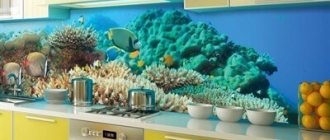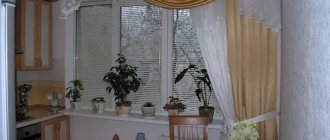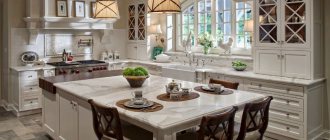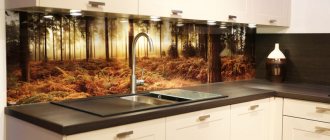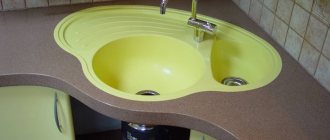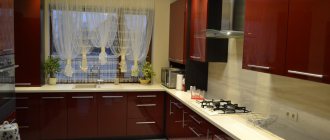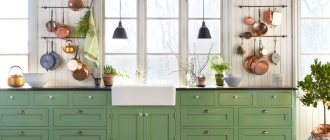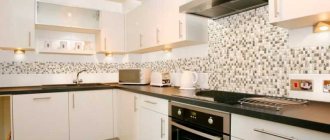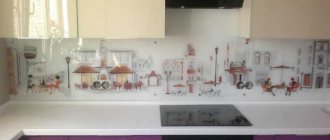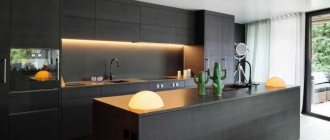About 5 years ago, only the most advanced Western designers knew what 3D panels looked like. It was difficult for us to imagine what voluminous skins are, which create unimaginable visual effects. Aluminum, plastic and even wood are used to decorate bedrooms, halls, and living rooms, but for the kitchen apron area they choose exclusively glass, onto which a pattern with a 3D effect is applied.
The versatility of glass and the design capabilities of the image will allow you to both protect the work area and create fantastic worlds.
The role of volumetric panels in design: nuances of selection and design
First of all, 3D panels are a fashionable trend in interior design that is not yet very widespread. This type of decoration brings additional volume to the room, creates interesting visual effects due to the play of light on the relief surface, and always becomes the central object against the background of the overall design.
Modern 3D panels for walls in the interior can be assistants in solving issues of zoning, finishing and decorating any horizontal or vertical surfaces, interior partitions.
Advantages and disadvantages
3D aprons have many advantages, among which are:
- This apron looks very presentable and stylish.
- Since the design is chosen individually, the product turns out to be unique, especially if the images are taken from the customer’s family archive.
- The 3D drawing creates the effect of presence, and animation and additional lighting can make the surface of the apron look like the screen of a huge TV.
- A 3D apron can be matched to almost any style and any interior.
- It has no joints, which means that dirt and dust will not accumulate between the panels.
- Resistant to high humidity, temperature changes, as well as various types of fumes.
- Glass and plexiglass panels are easy to care for, as they are not afraid of water, mechanical stress and household chemicals.
- They do not fade or crack over time; their appearance remains as attractive for many years as immediately after installation.
- Thanks to their reflective ability, glass panels and plexiglass panels visually expand the kitchen space.
- Relatively simple installation, which you can do yourself if you wish.
Interesting article: Design of aprons for a classic kitchen
Important! A glass apron or plexiglass apron is best mounted using self-tapping screws, special aluminum or plastic profiles and brackets. This will allow the structure to be securely fastened and will also make it possible to remove it without damage if necessary, for example, when repairing the wiring in the kitchen. Among the disadvantages of 3D aprons are:
- Panels made of glass and plexiglass cannot be mounted on an uneven surface: it must first be leveled and cleaned.
- Quite a long lead time for 3D aprons made to order.
- Not all people may be comfortable in a room decorated with panels that create an immersive effect.
Attention! Before ordering an apron for the kitchen with a 3D image that creates the effect of presence and, in particular, with an animation effect, discuss its design with your relatives, so that later, after purchase and installation, it does not turn out that any of them are uncomfortable in a kitchen decorated with 3D panels, for example, depicting fish swimming in the water.
Designer tips for using 3D panels
- Finishes with large volumetric textures are better suited for spacious rooms, while small patterns can be used even for small rooms.
- The relief wall itself, even white, is quite a noticeable decor. It is not always worth emphasizing it even more by painting it too brightly, with exciting colors.
- If brightly colored panels are used, other walls should be as light as possible.
- Visually, the 3D effect will be noticeable in any lighting. In addition, it changes depending on the viewing angle. To make it more obvious and interesting, the pattern is often illuminated with wall, floor, strip or ceiling lights.
- If the design involves the use of relief locally, as a separate art object, volumetric panels are perfect. Many manufacturers offer ready-made options, but you can also combine tiles from any collection to suit your taste.
- It is important to choose the right material in color and shape. Elements may have an ultra-modern design, then they will be an excellent complement to high-tech, modern, and techno styles. Classic motifs are more suitable for historical styles. And almost invisible, light and unobtrusive ones can be used even for ethnic ones.
- Wall panels are not only decoration, but also decor, so they should not be covered with bulky pieces of furniture, and they are almost never complemented by individual accessories.
- Quite deep textures are suitable for decorating living rooms, offices or studies, and delicate, soft and laconic ones look better on the walls of bedrooms or bathrooms.
- In addition to the variety of colors, surfaces can be matte or glossy, which is also important to consider when choosing a material. Glossy coating gives more optical effects and visually expands the space. Matte simply stands out with its texture, creating the necessary mood, complementing the atmosphere with comfort and tranquility.
3D design possibilities, or How to decorate a kitchen
Why do we choose a kitchen apron with a three-dimensional 3D image? Because it will attract attention and become the main design accent. Therefore, such decor will look best in a kitchen in the style of minimalism, modernism, hi-tech and any other style that is laconic and modern.
According to designers, the best “friend” of spectacular panels is simplicity. If the kitchen is designed in Provence, romantic or country style, it will be difficult to choose panels. Agree, next to wallpaper with small flowers and lace curtains, skins with a diving dolphin or abstract squares will look ridiculous. How to maintain harmony?
- Play with contrasts. Since we have chosen three-dimensional 3D, let such a kitchen apron become the main highlight. For example, your set can be selected in white or gray tones, but it is better to choose skins with a bright pattern. These can be juicy fruits, seascapes or three-dimensional figures - circles, squares. Even in the photo, aprons in kitchens, which are decorated in subdued colors, look impressive.
- Choose a perspective. Especially if you have a small kitchen. Panels with a light image that takes you into perspective can visually expand the space. What could it be? Night city with sparkle of lights, sea coast or abstraction.
- Combine with other details. A cozy atmosphere will be created by skins, the design of which echoes the decor of walls or textiles. For example, one wall of your kitchen is decorated with wallpaper with a picture of coffee beans. Let the same grains be on the apron. You can also choose products where the 3D base color will echo the main color of the kitchen. A yellow kitchen set, textiles or dining area can be complemented by yellow patterns on the apron. In the following photos, see how colored and monochrome volumetric panels look in interiors.
And one more design secret: the smaller the room, the more relaxed it is to choose a pattern.
An abundance of several colorful elements will look good only on large panels. In a small kitchen, such a varied apron will “steal” square meters and make the space narrow. It is best to choose products with one catchy image. It could be a flower, vegetables, a starfish or a coffee cup.
Types of decorative wall panels
In fact, it is not enough to cover a wall with any panels you like. Only those types of finishes that are correctly selected in size, texture and material can achieve the desired result, complement, and decorate the interior. Before going to such design delights, it is worth familiarizing yourself with the features of existing options, their advantages, as well as disadvantages.
Gypsum panels
Gypsum panels are one of the most common; they are safe, non-toxic, resistant to temperature changes, provide additional sound insulation, and have a long service life. The possibility of painting allows you to literally update the room in a few hours, bringing new notes. During installation, a seamless surface can be achieved. In case of damage, sandpaper with putty will help to carry out a quick restoration.
Plastic
In the manufacture of PVC wall panels, technologies are used that make it possible to create imitation of many natural materials, including finishing stone and wood. Polymers also successfully imitate the texture of fabric or leather, and some collections include panels actually covered with high-quality leather or textiles. Plastic panels have no equal in the variety of colors and textures. The depth of the relief depends on the thickness of the material and ranges from 30-120 mm. Plastic tiles are lightweight, waterproof, and easy to maintain.
Glass
This type of finishing was one of the last to appear and had not yet become very popular. Glass 3D panels for walls look very beautiful and have excellent quality characteristics, but not everyone can afford their price. In addition, due to their heavy weight, they are not suitable for all walls, especially partitions.
Aluminum
Recently, they have been used with pleasure by both professional designers and ordinary homeowners who have decided to update the interior on their own. The finish is not afraid of exposure to temperature or moisture, and is resistant to ultraviolet radiation and various alkaline environments. No further processing or coloring is intended. Manufacturing technology allows you to experiment with texture and color. Due to their light weight, they can be mounted even on plasterboard partitions, but the panels are attached to a frame made of metal profiles, so they will take up some area from the room.
Embossed MDF panels
Like previous options, MDF panels can have different textures, textures, and colors. They are made of high quality composition, which ensures stability and long service life. However, they are not recommended for use in rooms with high humidity, for bathrooms, saunas, baths. Painted surfaces are the most popular among designers. A special feature of MDF panels is the ability to use them not only as decoration for walls, but also for decorating partitions, furniture facades, and doors.
Selection of decorative 3D coating
The theme of three-dimensionality itself, if we talk about it in a broader sense than its use in decoration, has a broad meaning, because it is part of a trend. It is a fact that nowadays multi-dimensional spatial forms are becoming more common and appreciated in various fields of art. In the case of interior and exterior decoration, the 3D theme has effectively entered into houses and apartments and has become a sign of quality and modernity, present in everyday life, not just in art.
Of course, the choice of material for decorative coating is wide and varied. One thing is for sure - your choice, as well as the interior, will be able to reflect your character. And the existing offers of 3D panels on the modern construction market will undoubtedly allow you to do this.
Tags
3 d panels for walls 3D panels 3d panels 3 d panels
Application options for 3D panels
Based on many years of experience of designers and decorators, we can highlight the most successful options for using 3D panels in the interior of rooms for various purposes.
Panels in living rooms
It is the design of living rooms that is most often decorated with this type of decoration. Wall panels will be an original addition in the TV area. Models that imitate waves, water surface or modern geometric shapes look especially interesting.
The volume on the walls will highlight the fireplace area. At the same time, it is important to choose the right material so that the style of the hearth matches the style, texture, and finishing pattern. For rooms designed in a classic style, panels that imitate capiton fabric or carriage screed are often chosen.
At the same time, the light version looks discreet, but very advantageous, and with the dark one it is possible to give the room a certain mystical mood. Columns with a straight section, square, rectangular, panels will give a special chic, especially if they are supplemented with lighting.
Use in the kitchen
The second most popular option is to use 3D panels for walls in the interior of a kitchen or dining room. Here, as a rule, preference is given to plastic or MDF panels, since they are easy to care for and resistant to moisture. If we are talking about the use of gypsum materials, then they are additionally coated with water-repellent varnishes.
Most often, the material is used to line the working wall. You can also successfully highlight a dining area in the kitchen. In spacious rooms, this type of finishing can be used in two places at the same time, creating a more holistic design.
Bedroom decor
There are usually not many places in the bedroom where a voluminous texture will look advantageous. In most cases, this is the wall at the head of the bed. It is important that the selected texture and color of the material successfully complement the overall design.
If the decor has a small pattern, sometimes the entire sleeping area is highlighted: the decoration along the width of the bed is raised to the entire wall and placed three-quarters on the ceiling. In small rooms, a small decorative panel on the wall will look better. Less often, the wall opposite the bed is made voluminous, as a rule, if a TV is placed there.
For children's room
Some manufacturers offer a special range for children's rooms. Such panels often take the form of Lego cubes, various geometric shapes, and colors.
An interesting addition for a nursery would be a part of the wall with a wave-like texture, which is painted in rainbow colors. In children's rooms, this decor is recommended to be used only in the play area.
Bathroom cladding with 3D panels
In bathrooms, volumetric panels are used locally or to highlight a separate area in combined bathrooms. You can select any zone if you choose a material that is not affected by moisture and temperature.
Most often, the wall above the bathroom or a completely free wall is made voluminous. An unusual finish will help highlight the toilet area and will not put a strong emphasis on it if it is in lighter shades.
3D panels are such a diverse and versatile material that they can be used anywhere. In addition to the rooms described above, you can decorate the loggia, do wall decoration near the stairs, in the hall or hallway.
Why glass panels? 5 advantages of the material
What are skinali for the kitchen? Essentially, this is a piece of glass that can be made either in a monochrome color version or with a 3D image applied. Why use glass?
Firstly, it is this material that allows you to apply three-dimensional designs. This is done using special paints, and the image itself is applied to the reverse (back) side of the material.
Secondly, a glass apron, unlike an aluminum or wooden one, can be chosen for the kitchen. After all, the working wall here is constantly exposed to steam, moisture and temperature changes. What else is different about skins with a 3D effect?
- Resistant to high temperatures and moisture. Such panels can easily “survive” temperatures of 120 degrees and constant exposure to grease and steam. Security. A kitchen apron made of this material will even withstand the weight of a person, let alone “everyday” injuries. True, the glass may not withstand an end impact, but after installing the apron, the likelihood of such an “injury” is reduced to zero.
- Ease of care. No matter what kind of 3D design you have, you can clean it and remove grease. The image will not disappear or deteriorate. You can use any glass cleaning products, brushes and sponges.
- Choice of sizes. Skins with a 3D effect are chosen even by those who have large kitchens at their disposal. The panel can be 3 meters long, and joining several panels with a three-dimensional pattern is not difficult. You can decorate with such skinali both a small part of the apron and the entire wall adjacent to the kitchen set. Look at the following photos to see what the panels look like in different rooms.
- Ease of installation. Of course, you won’t be able to make skins with 3D volume yourself, but you can install the decor yourself. It is enough to know how to use a drill. However, let us clarify one point - the more accurately the installation is carried out, the more securely the panels will be fixed. By the way, to install a glass apron you do not need to perfectly align the walls.
Where are the shortcomings? It is worth noting the high cost of such a “spectacular” pleasure. If ordinary tiles or simple glass can be considered affordable options, then 3D panels will not be cheap. The cost, of course, will depend on the size of the skin and the complexity of the image.
Another drawback lies in dismantling the apron. If you decide to update your kitchen and change the design, you will have to remove the entire panel, take it to the workshop and replace the old 3D image with a new one. The cost of this service is comparable to a new kitchen apron.
Useful video
3D skinned apron for the kitchen with image animation, see the video below:
A 3D kitchen apron can transform the design of any kitchen, regardless of its style and overall color. With a stereo effect, two-dimensional perspective, equipped with lighting or even an animation effect, it will become the embodiment of any customer’s idea. This apron will not only decorate the interior, but will also serve as reliable protection for the walls from dust, high humidity, as well as grease and other contaminants. This is an excellent choice for anyone who wants their kitchen to look fashionable, stylish and modern.
Recommendations
When decorating the interior design of a kitchen, a 3D apron can either play the role of the main accent and attract attention to itself, or, on the contrary, almost dissolve in it due to the low color and tonal contrast in relation to the overall color scheme.
If you want to achieve the second effect, then the shade of the apron should be matched to the color of the walls, furniture, or even made transparent.
When the kitchen is decorated in one color scheme and you want variety, then a 3D apron in a bright, contrasting shade is very suitable for this. This will give the room more dynamism and make the interior more interesting.
Bright designs will look best in large, well-lit kitchens , while pastel designs, as well as achromatic and sepia tones, are well suited for decorating a small space.
Images of seascapes, waterfalls, fish and dolphins look neutral and fit almost any interior.
Illuminated kitchen backsplashes can dramatically change the overall flavor of the kitchen. This should be kept in mind when deciding to opt for such a model. Illumination in cold blue, indigo and turquoise tones can distort the perception of the color scheme of the decor and make it duller, while illumination in warm shades - red, yellow, orange or purple, on the contrary, will make the overall color of the kitchen brighter and more saturated.
Attention! For fire safety reasons, you should not install kitchen backsplash lighting yourself; it is better to entrust this task to specialists.
